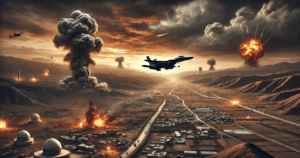Could Israeli Violence Lead to a Wider Middle East Conflict?
Israel’s ongoing attacks on Gaza and Lebanon, coupled with U.S. airstrikes on Yemen’s Houthi forces, are raising fears of a broader regional conflict in the Middle East. The fragile ceasefires that once held have now collapsed, escalating tensions across multiple countries. As violence intensifies, the risk of the situation spiraling out of control grows. Experts discuss the potential for the conflict to spread beyond its current borders. The discussion includes Alon Pinkas, a former Israeli consul, Randa Slim, an expert at the Wilson Center, and Nicholas Noe, an editor based in Beirut. The situation remains precarious, with the Middle East on edge.

Could Israeli Violence Lead to a Wider Middle East Conflict?
As violence escalates between Israel and groups in Gaza and Lebanon, and the U.S. conducts airstrikes against Houthi rebels in Yemen, fears are growing that the Middle East could be pushed into a broader, more dangerous conflict. With recent ceasefires collapsing and tensions surging, experts warn that the region is at a critical turning point.
Current Situation
Israel has significantly increased its military operations in Gaza in response to attacks by Hamas. At the same time, clashes with Hezbollah along the Lebanon-Israel border have intensified, raising concerns about a potential second front in the conflict. Meanwhile, the U.S. has launched strikes against Yemen’s Houthi forces, who have targeted international shipping routes in solidarity with Palestinians. These overlapping crises have disrupted fragile truces and heightened the risk of a regional war.
Expert Perspectives
To understand the risks, Nick Clark, the presenter, spoke with three regional analysts:
- Alon Pinkas (Former Israeli Diplomat)
Pinkas acknowledged Israel’s right to defend itself but cautioned that its aggressive tactics could backfire. He noted that while Israel aims to weaken Hamas and Hezbollah, prolonged fighting might unintentionally draw in other actors, like Iran. “The longer this goes on, the harder it becomes to control the narrative and the outcomes,” he said. He also emphasized the political pressure on Israel’s government to appear strong, which could lead to hasty decisions. However, Pinkas doubted that Iran or its allies would want a full-scale war, as it would destabilize the region further. - Randa Slim (Middle East Analyst, Wilson Center)
Slim highlighted the role of Iran-backed groups, such as Hezbollah and the Houthis, in widening the conflict. She explained that these groups are not just supporting Hamas but are also pursuing their own goals, like challenging U.S. influence in the region. “Every strike and counterstrike risks pulling more players into the fight,” she warned. For example, Hezbollah’s rockets into Israel could force Israel to retaliate more forcefully, escalating the Lebanon front. Similarly, Houthi attacks on ships might prompt further U.S. military involvement, creating a cycle of violence. Slim stressed that without urgent diplomacy, the situation could spiral beyond anyone’s control. - Nicholas Noe (Editor, Mideastwire.com)
Based in Beirut, Noe pointed to the humanitarian toll and political fractures in Lebanon as a powder keg. He argued that Hezbollah, already stretched by Lebanon’s economic crisis, might struggle to manage a prolonged conflict with Israel. However, domestic pressure within Lebanon—and Hezbollah’s desire to maintain its image as a “resistance” force—could push the group to escalate. On the U.S. role, Noe criticized American strikes in Yemen as “short-sighted,” arguing they risk uniting anti-U.S. factions across the region. “The U.S. is seen as directly backing Israel’s war, which fuels anger and mobilizes armed groups,” he said.
Risks of Regional Escalation
All three experts agreed that the biggest danger lies in miscalculations. For instance, an accidental strike on a sensitive target (like a religious site or a high-ranking leader) could trigger rapid retaliation. Additionally, public anger over civilian casualties in Gaza and Lebanon is radicalizing populations, making it harder for governments to pursue calm.
Iran remains a wild card. While it supports groups like Hezbollah and the Houthis, it has so far avoided direct confrontation. However, if Israel or the U.S. strikes Iranian soil—say, over a nuclear facility—Tehran might feel compelled to respond, dragging the region into war.
Is Diplomacy Possible?
Slim and Noe emphasized that de-escalation efforts are urgently needed but face major hurdles. The U.S. and Israel have shown little interest in ceasefires, focusing instead on military goals. Meanwhile, Arab nations like Egypt and Qatar, which often mediate, are struggling to influence Hamas or Hezbollah. Pinkas suggested that Israel might eventually shift tactics if global criticism mounts, but not before achieving its short-term objectives.
Conclusion
The Middle East is balancing on a knife’s edge. While full-scale war isn’t inevitable, the combination of military actions, broken truces, and regional rivalries makes the situation highly volatile. As Noe summarized, “We’re in a dangerous game where no one wants war, but everyone is preparing for it.” The coming weeks will test whether diplomacy can prevail—or if the region descends into a conflict with devastating consequences.
You must be logged in to post a comment.